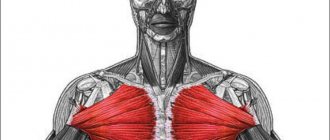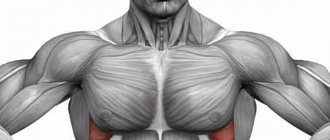What muscles need to grow. What stages does an athlete’s body go through on the path to success? How long might it take? When going to the gym, many beginners expect quick success. It would seem that it could be difficult - one or two months of active training and your figure will be like Schwarzenegger’s. Unfortunately, it's not that simple. Success in the sports field depends on many factors - body type, nutrition, correctness of the training program, and so on. Below we will try to analyze how long it takes to pump up and what is needed for this.
These answers are much more important than you think
Firstly, knowing the TRUTH about the speed and maximum muscle mass that, for example, can be gained in a month, you will be able to understand when the creators of various training programs, supplement manufacturers and other fitness gurus are lying to you, assuring you that you can build muscle much faster .
When you see that this is exactly what 95% of supplement manufacturers, workout program creators, and fitness experts promise every day, you will be less likely to fall for false promises.
Equally important, by understanding the actual rate and limits of muscle growth, you will have realistic expectations and will not set yourself impossible goals that will ultimately bring nothing but disappointment. Most of us (both men and women) expect to build a LOT more muscle in a FAR shorter period of time than our bodies are capable of.
men to rush from one stupid program to another, even crazier one, trying to find the one for “lightning-fast muscle growth”, which is impossible even with the use of steroids.
As a result, having not gained 5 kilograms of muscle mass in a week, which in their opinion they simply had to gain, people begin to blame it on the diet or training program and are embarrassed to change something that most likely should not have been touched (usually such changes only make things worse... “My biceps aren’t growing fast enough, which means I just need to do ten times more exercises!”).
For women, the situation is diametrically opposite. They also greatly exaggerate the expected muscle gain, BUT they do everything they can to avoid it because they don’t want to “bulk like a man.” That is why completely useless “Women’s workouts for muscle tone” appear almost every hour.
It doesn’t matter whether you are a man or a woman, you cannot achieve the desired result precisely because you do not understand what the real rate of muscle growth is and how much muscle mass you can gain in a month in the real world, and not in the world invented by the creators of advertising fitness programs. That’s why it’s time to analyze everything that will be written below and start changing right now.
Rate of muscle mass gain in girls
The structure of muscles, the characteristics of metabolic processes and the total volume of muscles in the fair sex are very different from those for men. Therefore, the figures given for girls will be completely different.
How many kg of muscle can a girl gain in a month? One of the studies showed that novice athletes gain an average of 3.54 kg in 6 months of regular training, that is, 0.59 kg in one month. This figure is approximately 60% of that for men.
The dynamics of muscle growth in subsequent years of training for both sexes is the same, that is, in the second year the girl will gain 50% of the weight of the previous year, in the third - 50% of the second, etc.
How Much Muscle Can You Gain... REALLY?
Year after year, thousands of smart people around the world never stop discussing how quickly and how many kilos you can actually gain. More than one study has been conducted on this topic.
Based on all this, over the course of your entire life you will be able to approximately gain the following amount of muscle mass (without resorting to medications):
- Average for men: about 18-22 kilograms of muscle over a lifetime;
- Average for women: about 9-12 kilograms of muscle over a lifetime.
Please note that in this case we are talking exclusively about muscles and not about weight. Of course, you can gain much more weight than muscle.
Also keep in mind that these are averages. There are always exceptions to any rule, who either cannot reach even the lower limit of the average, or easily exceed all the upper limits. This is influenced by a number of factors, so the indicators for each person will be different (we will talk about these factors a little later).
But for most people, most of the time... this is the maximum amount of muscle mass you can gain in your lifetime.
How to quickly pump up your arms with dumbbells
Dumbbells allow you to vary different exercises, and you can train with them either alternately or with two at the same time. First of all, you should think about safety. After all, even when training with light dumbbells, muscle rupture is possible. Therefore, it is worth reading the article How to properly pump up your arm muscles.
Training your arms with dumbbells has some disadvantages: dumbbells do not allow you to give a concentrated load to the external or internal biceps separately.
Therefore, it is very important to create a competent training schedule, where the emphasis will be on pumping up the weakest parts of the arms.
Exercises for biceps
- Curling arms with a barbell. To perform the exercise you need to use a narrow grip. You can load both heads of the biceps and brachialis.
- Alternating dumbbell bicep curls. This is an effective exercise for gaining muscle mass.
- Concentrated biceps curl with dumbbells. Exercise for pumping up the middle and lower biceps.
Triceps Exercises
- Extension of arms on a block. Use a neutral grip. All 3 triceps bundles are loaded. This requires a special simulator with an upper block.
- Overhead extension with dumbbells. When performing, use a neutral grip. The triceps are stretched at the bottom, making the exercise more effective.
- Bent-over arm extension with dumbbells. This is an effective exercise that will help further strengthen your triceps.
Building weekly training plans
Let's look at the three most effective training options:
- Biceps can be pumped with the back, and triceps with the pectoral muscles. During back training, a good load is provided for the biceps. The same applies to the pectoral muscles and triceps.
- Triceps can be pumped with the back, and biceps with the pectoral muscles. This will help to vary the load on the biceps. This allows you to lift heavier weights.
- Conduct arm training on a certain day. Biceps and triceps can be trained in one session.
Optimal diet
To quickly pump up your arm muscles, you should both train well and eat right:
You need to consume about 15% more calories than you burn. This is explained by the expenditure of energy on muscle synthesis. It should be noted that the male body synthesizes a maximum of 3 kg of muscle mass per month. The optimal rate of weight gain is 3-4 kg per month. Eating plenty of protein. Protein is one of the key “building materials” for the human body. In order to ensure muscle growth, you should consume 1.5-2 g of protein per 1 kg of body weight per day. Eat food immediately after training. The sooner you eat after training, the better. Frequent meals. It is recommended to eat 4 times a day. The less often a person eats, the more fat will accumulate in the body. Same amount of calories daily
Compliance with this rule is very important. You need to eat the same way both on days without training and on days with training, because the body needs proteins, carbohydrates and even fats
Features of recovery after training
Recovery after training takes quite a long time. If the training was intense, then the muscles are in a state of subcompensation, i.e. their size decreases in comparison with what it was before classes. The body needs to overcompensate for muscles - to make them larger than before training.
Depending on the depth of muscle subcompensation, recovery can last several weeks. The most optimal is short but intense training. You should work to the maximum of your capabilities.
Such training is very important, as it provides an adaptive response in the muscle. In order for muscle growth to continue, the intensity of the load must be constantly increased.
How long does it take to get pumped up...really?
So, we have determined the maximum possible increase in muscle mass. Next question: how long will it take?
Based on the performance of many of my clients and the clients of my colleagues, the results of a number of studies and my experience, which is more than 10 years, we can say the following.
Based on all this, the rate at which you can add muscle mass is as follows:
- Average for men: from 100 to 200 grams of muscle per week (this is about 0.5-1 kilogram per month);
- Average for men: from 50 to 100 grams of muscle per week (this is about 200-500 grams per month).
Again, this is pure muscle mass, not weight. In addition to muscle, the weight gained in a week can include (and most often does) fat, water and glycogen. But here we are talking exclusively about muscles.
And frankly, this rate of muscle growth is what you would expect under ideal conditions. That is, the ideal ratio of training and nutrients in the diet, the ideal amount of sleep every day, the ideal time for rest and recovery, the absence of stress and much more. Simply put, the closer your lifestyle is to this ideal, the faster you gain muscle mass (until you hit the ceiling described above).
And again... these are averages. Some people build muscle faster (rarely), others never reach that speed (the most common state of affairs). The exact amount of muscle mass and the rate of its gain per week, month, year depends on a number of individual factors. Speaking of factors, let's figure out what affects muscle growth.
Nutrition issue
For muscle growth you need “building” material and energy. If an athlete practices grueling training, but the number of calories entering his body from food is less than the number he expends every day, then the muscles will degrade! Therefore, an athlete who has set a goal to gain muscle mass must eat high-calorie and healthy foods.
Experts recommend adhering to the following rules:
- The diet should consist of 40% protein, 40% carbohydrates and 20% vegetable fats.
- For reliable muscle growth, you should eat 1 g of protein per 450 g of body weight. Protein products include meat, fish, cheese, cottage cheese, kefir, and eggs.
- You should avoid flour products and sweets, as they are high in unhealthy fats and low-quality carbohydrates. The latter are recommended to be obtained from fruits and vegetables. These carbohydrates are complex, so they are absorbed slowly by the body, providing it with energy throughout the day.
- The greater the number of meals, the better. Five meals a day is ideal.
How many times a week to lift bodybuilding
A typical situation, you are 17 years old, weight 50-60 kg, height 174-176 cm. Not to say that you are thin, but you are clearly far from a normal person :). Did you guess it?! I was like that myself.
Of course, you want to pump yourself up with bodybuilding and build some muscle. And a reasonable question arises: how much training should you do during the week? How many times should you exercise per week?
Attention!
The question, of course, is multifaceted. And to answer it, you should better know your body type and the speed of metabolic processes in the body.
I cannot ask you, so I will proceed from my parameters and personal experience of gaining muscle mass at 18 years old.
At 18 years old, I was 172 cm tall and weighed only 42 kg! Yes, that’s exactly what my everything was. All this made me terribly angry, I constantly heard exclamations addressed to me like “you’re so thin, eat something.” Damn, I ate as much per day as a normal person eats in 5 days.
Just a high level of metabolic processes, everything burned like in a furnace. It must be said that over the years, the rate of metabolic processes drops noticeably and gaining muscle becomes increasingly easier.
When I started bodybuilding, I began to eat even more. He ate literally everything that caught his eye. He ate all the time. I trained according to the scheme: 2 days of hard training, one day of rest. I have already written about this.
In 2 months I changed my body so much that people around me didn’t recognize me.
What happened, without chemicals, without sports nutrition, consuming only natural food in unlimited quantities, in 2 months of bodybuilding I did not gain a single gram of fat, but I increased up to 8-10 kg of weight, which means pure muscle! But let me remind you that after this period I fell into a state of terrible overtraining.
After all, I brought myself to exhaustion, sometimes I felt sick and vomited. On the uneven bars I was in tears during the last reps. Supersets of 4 exercises for 2 days of training every other day of rest are murder for the body. The mass grew by leaps and bounds, but then I did not know that this training regimen can only be carried out occasionally, shaking the body.
As a result, I drained all the body’s resources and went to bed with illnesses.
Today I walk at a slower pace. I train only 2 times a week. Each muscle group is trained no more than once every week and a half. Once every 4 workouts for a specific muscle group, I conduct super series. I eat as I wish. He ate what he wanted and when.
Important!
I try to listen to the voice of the body. And I must say that progress is obvious. Today I am already 30 years old and gaining muscle mass has become much easier.
Metabolic processes have slowed down, but at the same time energy drops, so sometimes I resort to sports nutrition at pro100gym.com.ua. I am no longer able to work my ass off like I did 12 years ago. Yes, actually, why tear it apart if the muscles are growing anyway.
When muscles don’t grow, then first of all you should rack your brains, think and look for the reasons for this. But who thinks at 17-18 years old?!
How you can quickly pump up your biceps at home
As we wrote above, you can use a horizontal bar for this purpose. However, there are some subtleties that should be taken into account:
- Pull up with a reverse grip.
- At the same time, try not to have a wide grip. It is this positioning of your hands that will allow you to quickly pump up your biceps at home.
- Do several approaches, approximately three to five. Do at least eight pull-ups at a time.
- The approach system can be replaced with a more interesting one - a “ladder”. It is perfect if you are working out with someone in pairs or with friends. The essence of the game is that you do not pull yourself up ten times, but sequentially - starting from one, gradually increasing the number of times up to ten, after which you “come back” back. It is worth noting that this game is actually quite exhausting - in total you will do a hundred pull-ups.
If you have obtained, or have already acquired, hardware, then things will go much faster. If you want to pump up your biceps, then you need to bend your arm at the elbow very often, while putting a load on it. In addition, there are two types of flexion: full and incomplete. It is their type that determines how your biceps will change. So, for example, an incomplete range of motion is better suited for working on “relief”, while a full range of motion is better suited for working on muscle mass. Very often, to limit movements at home, they use any support that you can rest your elbow on. Typically, these exercises are suitable for dumbbells.
If you have a barbell, then your actions will be slightly different. At the very beginning of training, you should decide on the weight of the load used. Here you should find a middle ground, because the quality of the exercises performed and their effectiveness will depend on this value. For example, if you hang a very heavy load, then after a large number of repetitions your technique may begin to limp. If you use a smaller load, then for better efficiency you will need to spend more time.
As soon as you solve the problem of the weight of the projectile, you can move on to classes. The technique of performing the exercise is very simple:
- Position yourself near good support. A wall is perfect for this.
- Grasp the barbell with an underhand grip.
- Straighten your back, standing straight against the wall.
- Start lifting the barbell towards your chest. Watch the position of your elbows - they should not move.
This is exactly what exercises for the full amplitude of flexion look like. In it, the main load goes to the biceps and back muscles, although only if you do not move your elbows. In addition to the above subtleties, it is worth considering one more thing: when you lower the barbell, try to keep your arms slightly bent and tense. This simple technique will provide you with an increased load on your muscles and improve the quality of your workouts. Also try to lower the bar as slowly as possible.
If you intend to do “relief”, then first of all you need to think about support, although in this case you may have problems. The best solution to the problem would be to visit the gym and train on special machines, or use unique household items - for example, a bench.
As you may have noted, in terms of home exercises, dumbbells have an undeniable advantage over a barbell. In addition to simplicity and convenience, using dumbbells allows you to load each arm separately and adjust the load on it. An ordinary stool is often used as a basis for training with dumbbells, on which the exercises are done in a sitting position. In this case, the thigh serves as a support. It is worth noting that before any activity you should definitely warm up and warm up your muscles - this will allow you to avoid injuries.
We hope that our article on how to quickly build biceps at home will be useful to you. Good luck with your training!
Stages of muscle growth
In the last article I already indirectly touched on these issues, but now I want to talk about everything in more detail.
We have already figured out that the progress of ANY PERSON is achieved in 4 stages:
- The stage of preparing the body for further hypertrophy (+3-4 months)
- Hypertrophy stage (+2-2.5 years)
- Hyperplasia stage (+1-2 years)
- System adaptation stage (tends to infinity)
Preparatory stage for hypertrophy
The shortest (about 3 months), but very important for future muscle growth! During these months, the body learns to use energy more economically, as well as to contract muscle fibers more efficiently. This can be easily tracked by a sharp increase in strength (increasing working weights).
The muscles also become visually larger and stronger. But this is not muscle growth! Simply, in this way, the body adapted to an external, previously unfamiliar load. The body learns to spend less energy, suffer less and increases stress resistance.
First, the body takes on the energy supply system. Muscle contractions require a lot of energy, so the body learns to store more and waste less. It increases “glycogen tanks” (the amount of glycogen stored in the muscles), as well as ATP.
To do this, the muscles begin to work more coherently, which is reflected in an improvement in the technique of performing exercises, as well as a sharp increase in strength. A beginner who came to the gym and squatted with a weight of 40 kg can already after 1-2 months increase the working weights to 60, or even 70 kg.
The muscles, moreover, did not become any larger, the body simply learned to use energy more efficiently.
In the first months, it is very important to teach the muscles to work CORRECTLY. Therefore, it is necessary to work with light weights to learn how to properly contract and feel your muscles.
How to pump up your arms correctly
Slow supersets
For example, when performing a superset of barbell curls and a French bench press, after 1 exercise, do not immediately proceed to the second, but rest for exactly 2 minutes, then perform a French press, rest again for 2 minutes and repeat the circle again.
Such a mini-rest will help you take on more working weight and allow the muscles to feel a new load with an unusual rest interval; all this will prevent the muscles from getting used to the load and will ensure an increase in sports results.
Long rest
Set aside 1 day specifically for training your arms, perform a set of 8-12 repetitions and rest for up to 10 minutes before starting the next approach, thus performing up to 10 approaches during the workout.
Of course, this workout will take a lot of time and only 1 muscle group will be trained, but this will allow the muscles to recover well at the same time and take on fairly decent weights, which will be an advantage for mass and strength.
Workout for two
In order to maximally load your arms, you need a partner who, in case of muscle failure under heavy weights, will be able to provide insurance and pick up the barbell or dumbbells before they cause injury to you.
But in our case, we will go further, first do warm-up 12-15 repetitions for 2 sets of barbell curls, then stand in front of each other with a partner and perform the exercise for 8 repetitions, after which pass the barbell to your partner, who should also do 8 repetitions, after which the barbell returns to you again and you again lift the barbell for 8 repetitions.
You should continue until the barbell falls out of your hands, this will allow you to maximally activate muscle fibers and get super benefits from the exercise, and the spirit of competition will force you to lift the barbell again and again, pure psychology to be a winner, but it is worth remembering that this training method You should not use it more than 1-2 times a month, otherwise overtraining will occur and the recovery period will take a long time.
Don’t focus on just exercises, it won’t bring tangible results.
Time to recover
The arm muscles are made up of small and large muscles, and some muscles tire faster and take longer to recover than others. Therefore, train your arms according to the 2-1 scheme, this means that for the first week train your arms 2 times a week, and for the second 1 time a week, then the scheme is repeated, 2 times a week and again 1 time, and so on.
This will allow unrecovered muscles to quickly return to a state of combat readiness before the next workout and train your arms more effectively.
Change of exercises and variety of workouts
Don’t get hung up on the same exercises; when you start training, there will always be favorite exercises and the most inconvenient ones. Therefore, you need to change the exercises periodically, uncomfortable and difficult exercises just indicate that the muscles are not accustomed to the load, they have not yet adapted and the return from the exercise is maximum.
Alternate exercises with a barbell and dumbbells, with your own weight and in simulators, do exercises at different angles and in different amplitudes, this will allow you to fully load your muscles, making them more powerful and voluminous.
Slow reps
Change the usual pace of the exercises, after a quick rise, lower the weight 3-4 times slower, this will increase the time of load under which the muscles are located, which will not allow it to rest for a long time and will allow you to maximally involve many muscle fibers in the work.
You should not always do this, since this method of pumping up your arms requires more strength than usual, so perform this technique 1-2 times a month or, in the very last approach, exercise your arms. During the exercise, you need to concentrate as much as possible on the feeling of the muscle being trained.
Use these methods of pumping up your arms and remember that without proper nutrition and sufficient recovery time, all your efforts will be wasted!
Watch this video on YouTube
Important points that will help you achieve your goal
Avoiding injuries
The complex should be performed very carefully and technically correctly to avoid injury:
Take care of your wrists This is the weak link in strength training. Minimal pain requires immediate cessation of exercise. There is no reason to train through pain. Moreover, it can lead to inflammation or result in serious injury.
Strengthen your hands With the help of a compact expander, you can strengthen your hands at any time convenient for the athlete.
Do not use belts Natural training without belts significantly increases grip strength and increases the effectiveness of the exercise. Moreover, there is an opinion that training beginners with belts leads to a decrease in forearm and grip strength.
How the program works
We do not suggest working exclusively with your hands for 29 days. On the contrary, continue to do the main program in parallel. In fact, research has shown that general exercises help maximize the growth of your biceps, triceps, and forearms by producing extra testosterone.
So, instead of dedicating a separate day to training your arms, simply add these exercises to the end of your regular workout.
Don't forget about your diet. To gain additional muscle size, you need to eat significantly more than before starting the program. But instead of focusing on the right amount of calories, just add a couple of protein shakes to your diet. That's all. The first will add 200-400 extra calories to your daily requirement, and the second will help your muscles grow faster.
As for sets of exercises, there are only two of them: Workout A and Workout B. Alternate them two to three times a week. For example, in the case of three classes a day, the sequence will look like this:
- Week 1: A, B, A.
- Week 2: B, A, B.
- And so on…
Please note that the number of approaches for some exercises is marked with an asterisk. This means that each new week you need to add one additional set.
For example, for exercise A2 in Workout A, do 5 sets in the first week, 6 in the second, 7 in the third and 8 in the last.
Believe me, such a systematic increase in training, while maintaining high intensity, works wonders on the biceps, triceps and forearm muscles.
Workout A
A1) Alternating arm curls with dumbbells
Approaches: 5*. Reps: 8. Rest: none.
Avoid rotating your body. Use only your hands to lift weights.
A2) Close grip pull-up
Approaches: 5*. Reps: 5. Rest: 30 sec.
Hang on the horizontal bar with a narrow grip and palms facing you. Squeeze your shoulder blades together and pull yourself up until your chin reaches the level of the bar. If you can, use a weight belt or vest.
B1) Close grip bench press
Sets: 3. Reps: 5. Rest: 30 sec.
Lie on a bench with your back, squeeze your shoulder blades together, and place your feet on the floor. Take the bar with a close grip and press, keeping your shoulders straight. Tighten your body right down to your heels, without lifting your buttocks from the bench.
C1) Curling arms with dumbbells with a “Hammer” grip
Sets: 3. Reps: 15. Rest: 30 sec.
Hold a pair of dumbbells with your palms facing your body. Bend your arms at the same time, raising them to your shoulders.
C2) Pull down rubber loop
Sets: 3. Reps: 50-75. Rest: 30 sec.
Attach the loop to a stable object above your head and grab the other side with both hands. Keep your shoulders still and extend your elbows all the way. Take the loop in a place where the level of resistance allows you to do 50-75 repetitions until fatigue.











